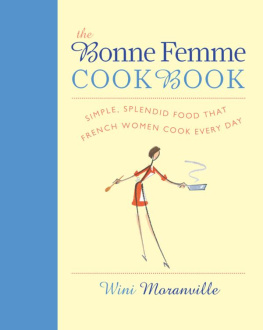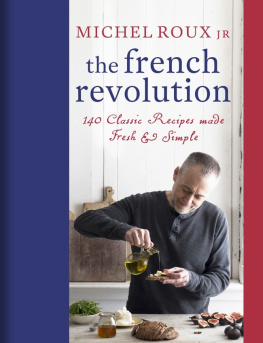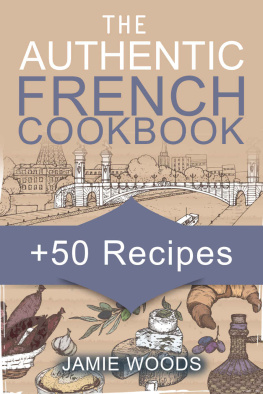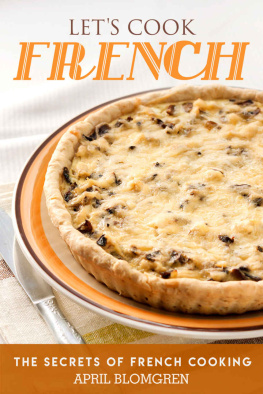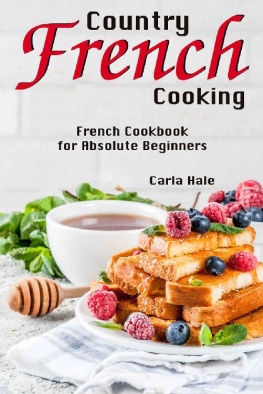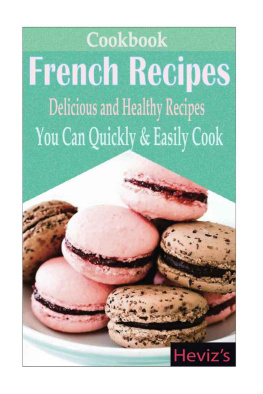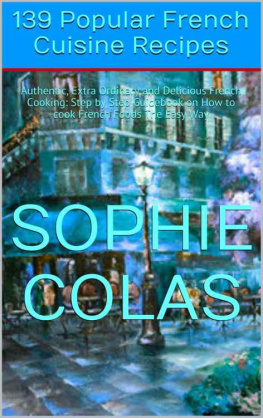Dedicated to the French cooks who opened my eyes
to the wonder and warmth of the everyday French table
The Harvard Common Press
535 Albany Street
Boston, Massachusetts 02118
www.harvardcommonpress.com
Copyright 2011 by Wini Moranville
Illustrations 2011 by Nishan Akgulian
All rights reserved. No part of this publication may be reproduced or transmitted in any
form or by any means, electronic or mechanical, including photocopying, recording, or any
information storage or retrieval system, without permission in writing from the publisher.
Printed in China
Printed on acid-free paper
Library of Congress Cataloging-in-Publication Data
Moranville, Winifred.
The bonne femme cookbook : simple, splendid food that French women cook every day /
Wini Moranville.
p. cm.
Includes index.
ISBN 978-1-55832-749-8 (alk. paper)
1. Cooking, French. 2. Cooking--France. I. Title.
TX7I9.M782 2011
641.5944--dc22
2011012157
Special bulk-order discounts are available on this and other Harvard Common Press books.
Companies and organizations may purchase books for premiums or resale, or may arrange a
custom edition, by contacting the Marketing Director at the address above.
Book design by Jill Weber
Illustrations by Nishan Akgulian
Author photograph by Richard Swearinger
10 9 8 7 6 5 4 3 2 1
Acknowledgments
How does one begin to acknowledge all of the talented and giving peoplefrom home cooks to culinary professionals to the cookbook authors who have come before mewho have made their mark on this book?
Above all, thanks to the Lavignes, the Burgundian family who warmly hosted me when I was 16 and then again on a return visit many years later, and who first revealed the spirit of everyday French cooking that inspires this book. The Briffeille family from Fleurance also shared their generous table, where I learned so much about the cooking of southwest France. More recently, Martine Baudonnet and Sebastian Frre both let me watch them cook unforgettable meals in their kitchens in French Catalua.
I've also had the great luck to travel through France with French professionals who have deepened my appreciation for that country's foods, drinks, and cooking. Aurlia Chimier accompanied me through the Comt region, where I discovered its wonderful cheese, which greatly enhanced my cooking. Jean-Louis Carbonnier introduced me to the Poitou-Charentes region, where I learned that Cognac is so much more than an after-dinner sip, while Bertrand Doux took me on a tour of the lesser-known wine regions of southwestern France and further deepened my appreciation for the cooking of that area. On my stays in France, many cheesemongers, butchers, greengrocers, ptisseurs, and restaurateurs were quick to share their insights on ingredients and cooking techniques; thanks go especially to the C. Canti-J. Rira shop, my boucherie in Collioure, the Lassalas pastry shop in Beaulieu-sur-Mer, and the beautifully simple Chez Palmyre restaurant in old Nice.
While most of this book's inspiration grew from meals I enjoyed in France, once home I relied on a range of cookbooks, magazines, and websitestoo numerous to mentionto help me effect reliable ways to replicate French recipes in the American kitchen. The 60-Minute Gourmet by the late Pierre Franey, for example, especially helped me seize upon the "Saute-Deglaze-Serve" method of cooking that inspired many recipes in this book. Chuck Williams, with his Simple French Cooking, also keyed me in to ways to bring some French favorites home. When I was truly stuck on a recipe, I'd ask myself, "WWJD?"What would Julia (Child) do?and her cookbooks often provided an answer.
Merci mille fois to my two editors. First, Dan Rosenberg, who asked me to write this book, then helped me shape it in a way that truly reflects my vision of everyday French cooking. And thanks to Roy Finamore, who asked difficult questions and paid attention to the kinds of details that made these recipes clearer and more user-friendly, while generously sharing his own knowledge on everything from seafood to potatoes. Pat Jalbert-Levine and Karen Wise, my production and copy editors respectively, also did great things for this book.
I would never have dared to write a cookbook had I not spent 15 years working with professionals from Meredith Corporation, publishers of the Better Homes and Gardens family of magazines and cookbooks. Thanks go to all of the editors and test kitchen pros I've worked with, starting with Lisa Holderness, Sandra Mosley, and Lois White, who transformed a French major wondering what to do next into a food writer and editor. Others who have inspired and taught me so much along the way include Jennifer Darling, Carrie Holcomb, Nancy Hopkins, Tricia Laning, Julia Martinusen, Shelli McConnell, Jan Miller, Charles Smothermon, Richard Swearinger, Joy Taylor, Kristi Thomas, Joyce Trollope, and Deb Wagman, as well as Lynn Blanchard and her entire staff in the Better Homes and Gardens test kitchen.
Thanks also go to friends and colleagues who helped me research, develop, test, and perfect these recipes. Ellen Boeke served as my right-hand woman throughout the entire project. David Feder shared his creativity for what ended up being some of my favorite recipes in the book, while Staci Scheurenbrand, Marcella Van Oel, and Patti Chong second-tested many of the recipes for me.
Thanks also go to Martine Baudonnet (again!), Kellie Bourque, and Muriel Gude, contemporary bonnes femmes in France, who patiently answered countless questions about how they cook and eat and who also helped me iron out tricky linguistic conundrums.
I'm also forever grateful to my grandmother, Anna Monthei, and my mother, Gladys Moranvilleboth of whom took great pleasure in cooking for others and in turn instilled that passion in me. To my husband, David Wolf, I am grateful for more things than I can mention here.
Introduction
It happened again, on the very day that I was to sit down and write this introduction. I mentioned to someone that I was writing a cookbook on easy, everyday French cooking.
"Really?" she asked. "Is there such a thing as easy, everyday French cooking?"
"Mais oui" I said, "but of course. And the best place to find it is chez la bonne femme."
Bonne femme is French for "good wife." But in French cuisine, the expression refers to a style of cooking. It is the fresh, honest, and simple cuisine served every day in French homes. It's called this no matter who does the actual cooking, whether the bonne femme herself, her mari (husband), or her partenaire domestique (significant other).
Everyday bonne femme cooking favors frugality over splurgesthe good wife knows how to make a beautiful meal from less-expensive cuts of meat; ease of preparation trumps fussy techniques any day. The good wife's cooking also marches to the beat of the seasonswhatever looks at its freshest, in-season best is likely to end up on her table. Intuition and improvisation are also keyFrench home cooks know how to substitute an ingredient they have on hand for something they don't, and how to make a pan sauce for just about anything (and you will, too, once you've cooked a few recipes in the "Saut, Deglaze, and Serve" chapter).
Few Americans are familiar with this casual side of French cooking. When we think of French food, we envision splurge-worthy, anything-but-everyday restaurants with a small army of chefs hovering over sauces for hours at a stretch, crafting elegant dishes that require obscure utensils, expensive ingredients, and architectural precision.
When we consider bringing French cooking to our own home tables, we picture slaving for three days over a cassoulet, hunting all over town for veal bones for a reduction, mail-ordering a lobe of foie gras or specialty cuts of wild boar, and stirring way too much butter and cream into every dish.
Next page
